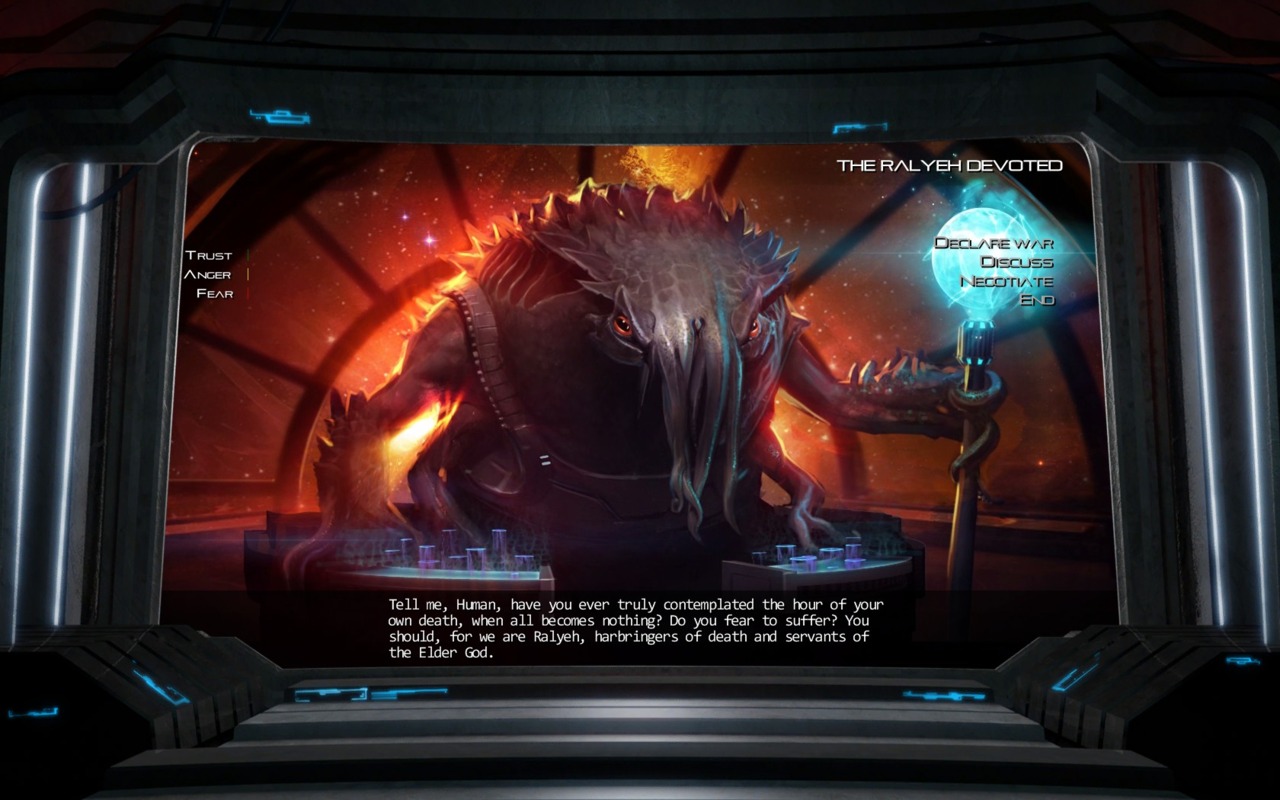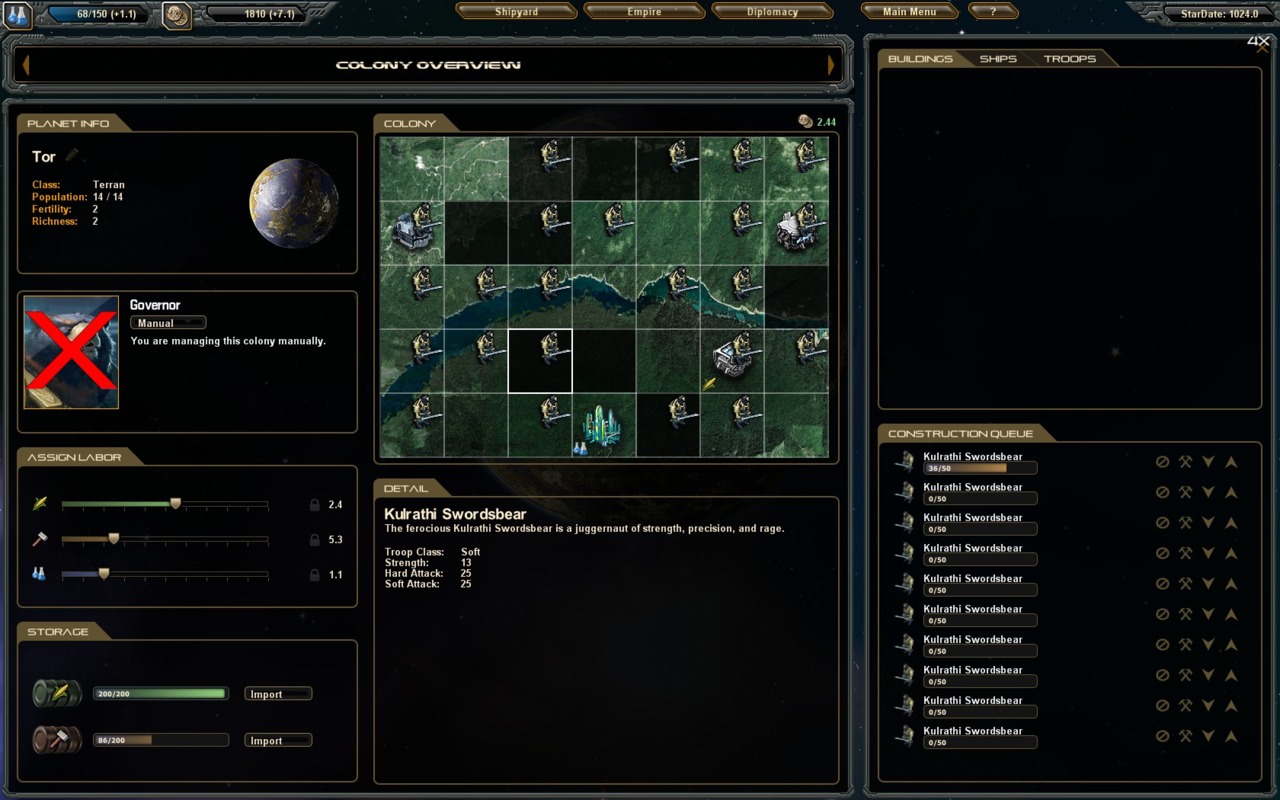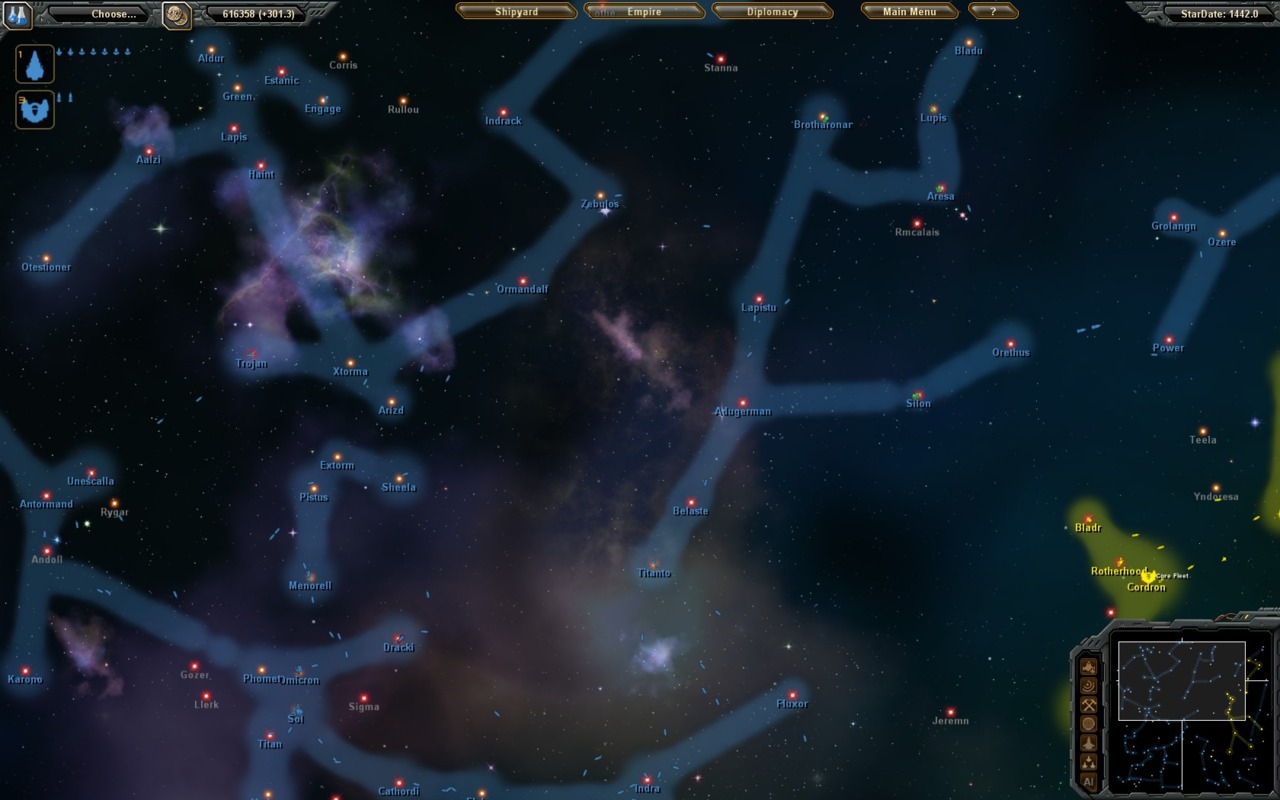Zero Sum Games' StarDrive seems like an extremely promising 4x strategy game at first glance. It has many things going for it: you can zoom out the camera to an almost omnipresent degree, design your own classes of starships, and take direct control of an individual ship and fly around with the keyboard. Unfortunately, many issues squander the game's potential and make it feel unfinished.
StarDrive is a turn-based 4x space game, but each turn is just a fixed number of seconds of real time at normal speed. In certain aspects, StarDrive resembles the Galactic Civilization series: you colonize planets, build structures on each colony's tile grid, design spacecraft, meet with and spy on other races, search for artifacts, and so on. Each planet produces a certain amount of resources based on its starting stats and how you manage it. Production, food, and population can be stockpiled or transferred between planets via freighters. So it's possible to create agricultural planets that feed industrial planets, which in turn can ship "production" to help other colonies complete building projects.
StarDrive offers several automation options to help fulfill your galactic empire aspirations. For example, you can click on the colonize button on unclaimed planets to send the nearest available colony ship to that world (it will order a nearby planet to build one if you don't have any such ships). Additionally, governors can be assigned to each planet and given orders to focus on things like research or industry. Also, the empire's shipyards can be ordered to commission freighters as needed. These options can be helpful, but you should personally build subspace projectors, the platforms that create space highways. These are costly to maintain, and the AI's grandiose infrastructure projects can bankrupt you.
Like many other games of its ilk, StarDrive allows you to design your own ships. Based on the technologies researched by your civilization, you can choose a hull type and place various modules on it. Each ship has a grid divided into engine slots as well as internal and exterior slots and a slot located between the interior and exterior of the ship. Every design is going to need engines, some sort of bridge, and a power source and power conduits. In addition, you can add various weapons, armor, and shield types as well as extras like fighter bays, ordnance storage, ordnance fabricators, sensors, and space for colonists. Weapons have a firing arc, so they need to be carefully positioned. Designing "invincible" battleships is enjoyable, but the design interface is unforgiving: one wrong click can replace large swaths of carefully designed power conduits and armor with a missile turret that you intended to place one grid away.

While designing spaceships is a major selling point of StarDrive, diplomacy is more interesting. For starters, the other civilizations have a lot of character. The emissary of the plant-like Pollops plays music from a sonoboard that also shoots out synthesized sunlight, the Samurai Bears of the Kulrathi shogunate greet you with a haiku, and the Lovecraft-inspired Ralyeh Devoted patiently explain the need to destroy everything in the universe for the benefit of their elder god. Additionally, diplomacy is deeper here than in many strategy games. Instead of giving your relationships a simple numerical value, each faction has different levels of trust, anger, and fear toward your civilization. If other factions trust you, then they're more likely to agree to proposals like alliances or forming a federation, which annexes their empire through diplomacy.
On the other hand, doing things like colonizing a system other factions have staked a claim to, sponsoring rebellions on their planets, or offering them insulting trade deals can lose their trust and make them angry. Finally, fear represents their respect for your power. If other civilizations are angry and unafraid, then you can expect war. Opportunistic allies, tempted by easy conquests, may betray you. Sadly, it's too easy to accidentally declare war on your allies by clicking on that option in dialogue. Such a drastic action clearly needs a confirmation box.
War is pretty much inevitable in StarDrive, unless you are a master diplomat backed by a giant fleet. For the most part, ship combat plays like in a typical RTS game, complete with control groups. However, you can assume direct control of any ship and guide its movement, which is useful for concentrating the maximum amount of firepower against an enemy ship. You'll probably be too busy controlling large fleets to micromanage a single ship, but it is a cool option.

The ground combat part of StarDrive is unsatisfying. By default, the AI controls your units, and this is probably for the best given that one wrong click can make your infantry attack one another. More problematic is that the ships transporting ground units are hard to intercept if other enemy craft are present. Thankfully, ground units don't require upkeep and automatically become troop transports when ordered to leave a planet, so you can just spam tons of units and send them off to defend threatened systems. Unfortunately, you have to be extremely precise when ordering space marines to exit a planet, because you have to right click on a ground unit to send it into orbit, and by default, right clicking anywhere else exits the colony view screen.
Besides the ground combat and problems derived from imprecise mouse clicks, there are various additional issues. First off, the tutorial is a woefully inadequate collection of 23 noninteractive slides. Furthermore, you might suffer through crashes and ludicrously low frame rates during massive wars. The most disappointing aspect, however, is that StarDrive is obviously incomplete. The only game type available is a single-player sandbox, though the manual mentions an ascension mode where the goal is to "ascend to godhood." Also, the manual promises that you can watch tutorial videos by pressing the tutorial button, but there are no videos--just the aforementioned slideshow.
Additionally, there are some in-game events that go nowhere. You encounter a race that has not yet achieved spaceflight, and depending on your actions, there is a promise that they will meet with you again. However, these people never reappear. Furthermore, there are events related to the remnants of an ancient alien race. Defeating enough of their units opens up a secret tech tree (consisting of only two techs), and further events send you looking for a portal hidden away on a random planet. If you find it, you fight a powerful remnant mothership, but no additional techs or events occur after that, despite indications to the contrary.

The character designs and animations of the foreign emissaries are very well done. For example, the hologram used by the emissary of the Drylocks occasionally malfunctions, revealing the purple-skinned humanoid to be a skeletal monster; meanwhile you can watch the robot that controls the Cordazine Collective pump mind-altering chemicals into its anthropomorphic owl slaves. However, the ships and land units are fairly ugly, but that isn't much of an issue since you'll probably spend most of your time zoomed out to a god's-eye view of the galaxy.
StarDrive's problems make it difficult to recommend without reservation. The ability to design your own ships, the unique diplomacy system, and the colorful factions make StarDrive an entertaining strategy game, and the mod support bodes well for its future. However, StarDrive promises more than it delivers, making it feel more like a beta than a finished game. It has great potential, but at this time, it's best to wait until the game is feature-complete.
